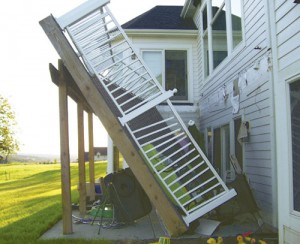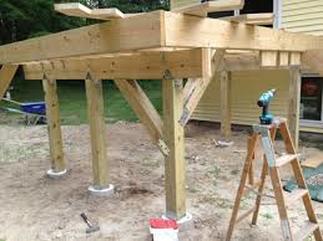Decks - A Modern Definition A typical deck of a home is constructed of a wooden platform built above the ground, although many decks are just built upon and raised above the surrounding surface of the ground. For many years, decks were typically connected to the home's structure, however, recent design requirements by municipalities require a deck to be freestanding for rot protection of the home and safety of the deck structure. A deck surface above the surrounding ground or surface 36 inches or more is required to have a surrounding railing for safety. Railings must support 200 pounds of lateral force at the top edge without "considerable" movement that would cause concern in an average individual. The railing must be designed to not have openings of more than 4 inches which can allow an infant to fall off of the deck to their death. Decks with stairways must have a handrail that can be grabbed by a typical person's hand for support from falling.
While some decks are constructed as floating or cantilevered structures tied into the main home's structure, if they are built of wood, they are still considered decks for the purpose of design, inspection, and safety, although they may be called balconies. ADA compliant decks and ramps must also meet standard width requirements for wheelchairs. Why Inspect Most decks are still made at least partially with wood. Even though pressure treated with rot-resistant chemicals, rain rusts the steel connectors, sun bakes the wood, and wind drives rainwater in and chemicals out. Loads of decks were build in the 1980's when decks came into their most popular era, and many, many of them are still around and in use. Many of the decks built in that era were not build to any building standard, and because of deck failures and the subsequent deaths of many individuals, deck standards were developed and strengthened. Twenty years is considered a good test of time for new materials and designs in the construction industry. In that 20 year period nature and use tend to prove or disprove if the quality, longevity, and design standards were correct or flawed. We have learned much with regard to decks in that period.
While deck standards, materials, and designs are now much stronger based on the failures and lessons learned over the years. Even with decks built to the newer standards, they are still prone to the forces of nature, and human use and modification, and still need to be inspected on a regular basis. In 2021, inspector Don of MHBI was interviewed by WUSA9 after a devastating, but typical deck failure in Maryland. You can watch the discussion video of the piece which aired by clicking here. WUSA9 also did a follow-up interview with a Montgomery County Maryland employee who discussed problems which caused the serious deck collapse weeks earlier. View that video here. Deck History & Construction Outdoor raised structures have been built from a variety of materials for centuries. Exterior decks as we know them arrived in the mid-1940's with the end of WWII and the development of the modern suburban homebuilding industry and neighborhoods. Prior to that era, outdoor structures were front, rear, or side porches that were mostly covered from damage by the elements. With the development of the chemical treatment of lumber, outdoor structures began their rise in popularity, really taking off in the 1980's.
The most popular past wood preservative, Chromated Copper Arsenate (CCA) was the primary preservative with a track record of decay resistance, until health concerns about the chemical led the wood treatment industry to stop using it for residential lumber in 2003. CCA retention levels were .25 for above-ground use and .40 for ground contact. Current retention levels vary depending on the preservative used. Today's typical wood treatment has retention levels of .06 for above-ground use and .15 for ground contact. There are now a number of pressure treated lumber preservative cocktails using a range of inorganic chemicals such as: Alkaline Copper Quaternary (ACQ), Copper Azole (CA), Sodium Borate (SBX), and Micronized Copper Quaternary (MCQ). While copper has been known for centuries to be a great protection against microorganism growth, these newer treated wood products may be less toxic, but contain a higher level of copper which is more corrosive to the steel brackets and fasteners than the past CCA-treated lumber. Decks have typically been constructed from pressure treated lumber, however, over the years a multitude of other composite decking materials have come and gone. Decking is the surface boards that one walks on. The alternative deck plank "board" materials can be some of the following: aluminum, varieties of lumber, recycled materials, and plastics. Recycled planks may be high-density polyethylene (HDPE), polystyrene (PS) and PET plastic as well as mixed plastics and wood fiber (often called "composite lumber" or "wood-plastic composites", which are generally more widely known by specific brand names. Deck SafetyDeck safety inspections look at a number of stress points in a deck and the health of the connection hardware and materials. Briefly, the following major items are inspected when they can be viewed:
■ Footings, Deck Supports, Posts & Columns ■ Ledger Board (connection to the home) and related flashing and sealant ■ Beams & Joists ■ Stairs and Landings ■ Deck Boards, Materials, and Surface ■ Railings, Handrails, and Fall Guards ■ Metal Connectors and Brackets ■ Electrical Wiring, Lighting, and Outlets Deck Standards The following deck standards are useful when designing a deck or reviewing a constructed deck. Note that new construction or replacement of a deck requires a building permit.
■ Fairfax Co Deck Standards (2012 VA Code): www.fairfaxcounty.gov/dpwes/publications/decks/details.pdf ■ Arlington Co Deck Standards (2009 VA Code): https://arlingtonva.s3.dualstack.us-east-1.amazonaws.com/wp-content/uploads/sites/38/2016/08/BLENDED-2009-DECK-DETAILS-Inspection-Services-Division-1.pdf ■ North American Deck & Railing Association: www.nadra.org Deck Inspections MHBI is trained and certified to modern deck design standards through the North American Deck and Railing Association (NADRA.org) and can provide a comprehensive deck inspection. A key element of enjoying your deck for years to come is making sure it is structurally sound and is not seriously deficient in its design and installation methods based on current standards. NADRA’s “10-Point Consumer Safety Checklist” is a basic guide for viewing and inspecting the different parts of your deck, with an eye to what might need maintenance, repair, or replacement.
Mike Beaudry, executive vice president for NADRA has stated that one should consider a professional inspection. “A professional inspection will examine every inch of your deck, provide information on your deck’s capacity limits, identify any dangerous problem areas and give you a map of what to keep your eye on in the future. If your deck is older, this might include a regular deck inspection schedule,” Beaudry has stated. Older decks require closer scrutiny. Many of these decks were built before code requirements were in place to protect consumers. Some of these decks may have deck-to-house attachments using only nails. If your deck is older, it is even more important to have it inspected by either a NADRA certified deck inspector or a knowledgeable deck builder (see contractor listings at nadra.org). NADRA member deck builders are required to adhere to a code of ethics and comply with state licensing and insurance requirements. If you find your deck is not safe to enjoy, NADRA advises taking immediate action to have it repaired or rebuilt as necessary. To choose a deck builder, here are some tips: ■ Ask friends and family members for referrals and contact state and local licensing authorities and trade associations such as NADRA. ■ Pay attention to the deck builder’s experience, licensing, insurance coverage and professional references. Not all companies who claim to be deck builders are experienced or trained with an understanding in the physics of carrying loads through wood materials and fasteners. ■ Meet with and carefully evaluate all potential deck builders. Ask to see a portfolio and some samples of the decking and railing materials they prefer to use. Good builders take pride in their work and should be willing to provide references to past installations or repairs. ■ When hiring a deck builder, there is more to consider than just price. ■ In addition, contact your municipal building construction, permitting, and inspection department to determine what is required for the installation or replacement of a deck or balcony structure, and to speak with an inspector knowledgeable about their deck construction requirements. Remember, a deck or balcony is more than just a wonderful structure where you can enjoy the outdoors - It is a physical structure which must be able to carry significant loads of all persons who may be standing, sitting or dancing, and must be able to withstand the testing of Nature through the constant abuses of sun, wind, rain, corrosion, and microbial growth. |
More Information
For more information, we want to thank the following organizations for providing valuable information:
* North American Deck and Railing Association (NADRA.org)
* Popular Mechanics - Pressure Treated Lumber Guide
* North American Deck and Railing Association (NADRA.org)
* Popular Mechanics - Pressure Treated Lumber Guide







